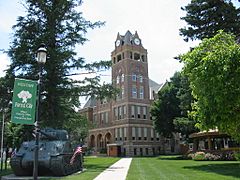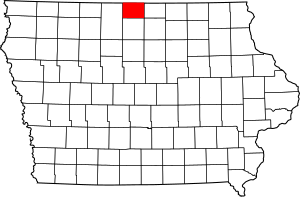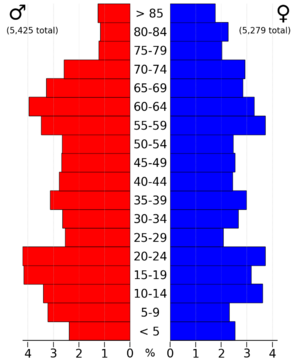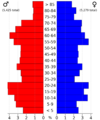Winnebago County, Iowa facts for kids
Quick facts for kids
Winnebago County
|
|
|---|---|

Winnebago County Courthouse in Forest City
|
|

Location within the U.S. state of Iowa
|
|
 Iowa's location within the U.S. |
|
| Country | |
| State | |
| Founded | 1847 |
| Named for | Winnebago tribe |
| Seat | Forest City |
| Largest city | Forest City |
| Area | |
| • Total | 402 sq mi (1,040 km2) |
| • Land | 400 sq mi (1,000 km2) |
| • Water | 3.3 sq mi (9 km2) 0.3% |
| Population
(2020)
|
|
| • Total | 10,679 |
| • Density | 27/sq mi (10/km2) |
| Time zone | UTC−6 (Central) |
| • Summer (DST) | UTC−5 (CDT) |
| Congressional district | 4th |
Winnebago County is a place in Iowa, a state in the United States. In 2020, about 10,679 people lived here. The main town, or county seat, is Forest City. The county started in 1847 and got its name from the Ho-Chunk Native American tribe. It's also where the famous Winnebago Industries makes motor homes!
Contents
About Winnebago County's Land
Winnebago County covers about 402 square miles. Most of this area, around 400 square miles, is land. The rest is water, like lakes and rivers. It's one of the smaller counties in Iowa.
Neighboring Counties
Winnebago County shares its borders with several other counties:
- Faribault County, Minnesota (to the northwest)
- Freeborn County, Minnesota (to the northeast)
- Worth County (to the east)
- Hancock County (to the south)
- Kossuth County (to the west)
- Cerro Gordo County (to the southeast)
Getting Around Winnebago County
You can travel through Winnebago County using different roads and even an airport.
Main Roads
 U.S. Highway 69
U.S. Highway 69 Iowa Highway 9
Iowa Highway 9
Local Airport
- Forest City Municipal Airport
Who Lives Here? (Demographics)
| Historical population | |||
|---|---|---|---|
| Census | Pop. | %± | |
| 1860 | 168 | — | |
| 1870 | 1,562 | 829.8% | |
| 1880 | 4,917 | 214.8% | |
| 1890 | 7,325 | 49.0% | |
| 1900 | 12,725 | 73.7% | |
| 1910 | 11,914 | −6.4% | |
| 1920 | 13,489 | 13.2% | |
| 1930 | 13,143 | −2.6% | |
| 1940 | 13,972 | 6.3% | |
| 1950 | 13,450 | −3.7% | |
| 1960 | 13,099 | −2.6% | |
| 1970 | 12,990 | −0.8% | |
| 1980 | 13,010 | 0.2% | |
| 1990 | 12,122 | −6.8% | |
| 2000 | 11,723 | −3.3% | |
| 2010 | 10,866 | −7.3% | |
| 2020 | 10,679 | −1.7% | |
| 2023 (est.) | 10,571 | −2.7% | |
| U.S. Decennial Census 1790-1960 1900-1990 1990-2000 2010-2018 |
|||
Population in 2020
In 2020, 10,679 people lived in Winnebago County. This means there were about 27 people for every square mile. Most people (about 96%) said they belonged to one race. There were 5,077 homes, and 4,512 of them were lived in.
Here's a quick look at the different groups of people living in Winnebago County in 2020:
| Group | Number | Percentage |
|---|---|---|
| White | 9,472 | 88.7% |
| Black or African American | 204 | 2% |
| Native American | 13 | 0.1% |
| Asian | 94 | 0.9% |
| Pacific Islander | 3 | 0.03% |
| Other/Mixed | 299 | 2.8% |
| Hispanic or Latino | 594 | 5.6% |
History of Winnebago County
When the first European settlers arrived, groups of Ho-Chunk (also known as Winnebago) Native Americans lived in the county. They often stayed near Lime Creek or Coon Grove. Sometimes, there were many of them, and other times, just a few. They would go north to Minnesota to hunt and trap during the summer.
The Ho-Chunk people were later moved from the area after the Dakota War of 1862.
The first European settlers built homes in the eastern part of the county, which had more trees. The western parts, with prairies and marshy areas, were settled later, after 1880. Many early settlers in Winnebago County were from Norway.
The oldest building still standing in the county is Trinity Church, which was built in 1874.
In 1938, the Winnebago Rural Electric Cooperative was started. This group helped bring electricity to homes in the area. The first power lines were turned on in 1940.
In 1951, a movie was made about how hard it was to get good phone service in Winnebago County. This was before a federal loan helped the Winnebago Cooperative Telephone Association bring modern phone service to the area.
The famous Winnebago Industries, which makes recreational vehicles (RVs), was started in Forest City in 1958.
You can learn more about the county's past at the Winnebago Historical Society, located in the Mansion Museum in Forest City.
Towns and Communities
Winnebago County has several towns and smaller communities.
Cities in Winnebago County
Population of Cities (2020)
Here are the cities in Winnebago County, listed by how many people lived in them in 2020:
† This means it's the county seat (main town).
| Rank | City/Town | Type | Population (2020 Census) |
|---|---|---|---|
| 1 | † Forest City | City | 4,285 |
| 2 | Lake Mills | City | 2,143 |
| 3 | Buffalo Center | City | 857 |
| 4 | Thompson | City | 495 |
| 5 | Leland | City | 249 |
| 6 | Rake | City | 186 |
| 7 | Scarville | City | 74 |
Schools in Winnebago County
Here are the school districts that serve students in Winnebago County:
- Algona Community School District
- Forest City Community School District
- Lake Mills Community School District
- North Iowa Community School District
Some school districts have joined together over the years:
- Titonka Consolidated School District joined Algona CSD in 2014.
- Woden-Crystal Lake Community School District joined Forest City CSD in 2013.
Images for kids
See also
 In Spanish: Condado de Winnebago (Iowa) para niños
In Spanish: Condado de Winnebago (Iowa) para niños






